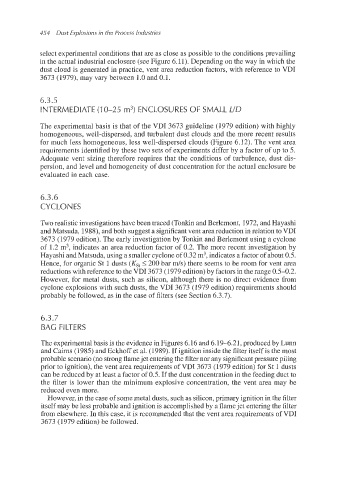Page 487 - Dust Explosions in the Process Industries
P. 487
454 Dust Explosions in the Process Industries
select experimental conditions that are as close as possible to the conditions prevailing
in the actual industrial enclosure (see Figure 6.11). Depending on the way in which the
dust cloud is generated in practice, vent area reduction factors, with reference to VDI
3673 (1979), may vary between 1.O and 0.1,
6.3.5
INTERMEDIATE (10-25 m3)ENCLOSURES OF SMALL LID
The experimental basis is that of the VDI 3673 guideline (1979 edition) with highly
homogeneous, well-dispersed, and turbulent dust clouds and the more recent results
for much less homogeneous, less well-dispersed clouds (Figure 6.12). The vent area
requirements identified by these two sets of experiments differ by a factor of up to 5.
Adequate vent sizing therefore requires that the conditions of turbulence, dust dis-
persion, and level and homogeneity of dust concentration for the actual enclosure be
evaluated in each case.
6.3.6
CYCLONES
Two realistic investigationshave been traced (Tonkin and Berlemont, 1972,and Hayashi
and Matsuda, 1988),and both suggest a significant vent area reductionin relation to VDI
3673 (1979 edition). The early investigation by Tonkin and Berlemont using a cyclone
of 1.2 m3, indicates an area reduction factor of 0.2. The more recent investigation by
Hayashi and Matsuda, using a smaller cyclone of 0.32 m3,indicates a factor of about 0.5.
Hence, for organic St 1 dusts (KstI 200 bar ds) there seems to be room for vent area
reductions with reference to the VDI 3673 (1979 edition) by factorsin the range 0.5-0.2.
However, for metal dusts, such as silicon, although there is no direct evidence from
cyclone explosions with such dusts, the VDI 3673 (1979 edition) requirements should
probably be followed, as in the case of filters (see Section 6.3.7).
6.3.7
BAG FILTERS
The experimentalbasis is the evidencein Figures 6.16 and 6.19-6.21, produced by Lunn
and Cairns (1985) and Eckhoff et al. (1989). If ignition inside the filter itself is the most
probable scenario (no strong flamejet entering the filter nor any significantpressurepiling
prior to ignition), the vent area requirements of VDI 3673 (1979 edition) for St 1dusts
can be reduced by at least a factor of 0.5. If the dust concentrationin the feeding duct to
the filter is lower than the minimum explosive concentration, the vent area may be
reduced even more.
However, in the case of some metal dusts, such as silicon,primary ignition in the filter
itself may be less probable and ignition is accomplishedby a flamejet entering the filter
from elsewhere. In this case, it is recommended that the vent area requirements of VDI
3673 (1979 edition) be followed.

